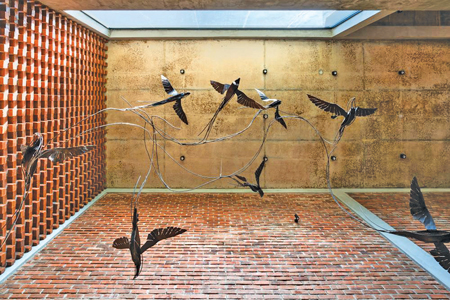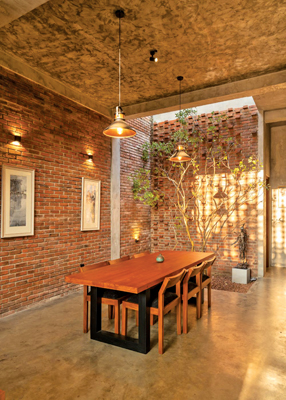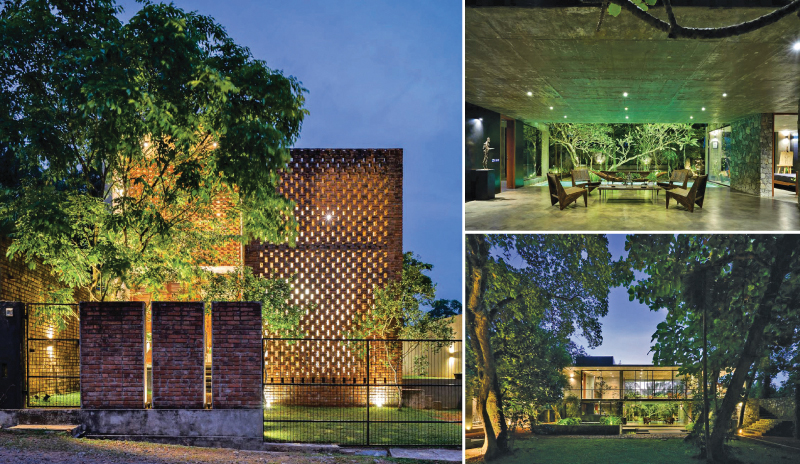 The Architectural community forum is currently concentrated on the promising ‘Young architect 2025’, Dishna Thilanka, who won not one but four awards in a single night for his surprisingly simplistic but nuanced mastery in his chosen field.
The Architectural community forum is currently concentrated on the promising ‘Young architect 2025’, Dishna Thilanka, who won not one but four awards in a single night for his surprisingly simplistic but nuanced mastery in his chosen field.
Like most children in Sri Lanka, Dishna has also been a part of a middle-class family of five, his parents, his two younger sisters and him in Maharagama. He had spent much of his childhood and young adulthood in Maharagama, choosing to shift schools to Royal College, Colombo for his Advanced Level studies in the Arts stream. This shift has marked that first step in his visionary journey.
A spontaneous decision led Dishna towards architecture, but art had long been his language of expression. Influenced by his father, a traditional artist, Dishna spent his childhood amongst ‘Gokkola’ and ‘Banana Trunks’, collaborating on projects and creations of his father, gaining a deep foundation in artistic traditions. Art was his first love, and his teacher’s encouragement to pursue his talent planted a seed that would later bloom into an architectural career.
Turning point
Dishna’s journey into architecture was anything but conventional. Though his heart leaned towards the arts and his mind towards physics and mathematics, a spontaneous application to study architecture became a life-changing moment. Among only 50 students selected for the esteemed Architecture University, he embraced the opportunity with a blend of curiosity and determination. Balancing academic rigor with part-time jobs to support his family, Dishna exemplified resilience.
 Despite receiving offers to study abroad, including in Japan, he chose to remain in Sri Lanka. For him, success meant contributing to his homeland by creating monuments that reflected his roots, culture, and environment.
Despite receiving offers to study abroad, including in Japan, he chose to remain in Sri Lanka. For him, success meant contributing to his homeland by creating monuments that reflected his roots, culture, and environment.
In his final year, his design had been chosen as the ‘final project design’ and he had been amongst the top scoring students, cementing his reputation as one of the university’s top talents. Dishna credits his educational growth to his own research, experimentation, and intrinsic connection to nature.
Dishna’s philosophy centres around finding harmony between man and nature.
Balancing ideology and practicality
While Dishna values artistic vision, he recognizes the importance of balancing creativity with practical and financial constraints. By “playing with elements,” as he describes it, he finds originality without compromising purpose.
When it comes to mentorship, Dishna is proudly self-taught. He describes himself as a composition of many styles and philosophies yet molded by none. His curiosity and relentless pursuit of knowledge have been his greatest teachers, allowing him to blend theory with practical application seamlessly.
He admits to having received help and guidance and assurance in the support of his teachers who had never restricted or chained him to structure and is immensely grateful while also being grateful for himself for not ‘limiting’ or ‘stereotyping’ his experiences nor education to what he has perceived over the years and putting his own, individual taste to it.
Finding the balance
For Dishna, architecture is not just about ‘constructing buildings,it’s about creating meaningful connections. He views it as a medium for exploring feelings, sentiments, and creativity.
 As an avid musician himself, a guitarist primarily, the balance of aesthetics with theoretical education isn’t novel to Dishna. He alluded music to a siren, evoking feelings, emotions and sentiments and doesn’t consider his architectural work to be mutually exclusive from his creativity but rather a form of capturing the very essence of his individualistic sentiments.
As an avid musician himself, a guitarist primarily, the balance of aesthetics with theoretical education isn’t novel to Dishna. He alluded music to a siren, evoking feelings, emotions and sentiments and doesn’t consider his architectural work to be mutually exclusive from his creativity but rather a form of capturing the very essence of his individualistic sentiments.
Although he doesn’t have any certain mentorship figure in his life, he does have a few favourites when it comes to architectural legends such as Leonardo Da Vinci, Geoffrey Bawa and artists such as Pablo Picasso.
Dishna also considers himself a combination of bit of ‘everything and anything’ who doesn’t want to embrace a singular style for himself but something unique of his own creation with features of everything he learned and adored. He is in pursuit of ‘not fitting himself not a mold’ but ‘making a mold’ of his own style.
Architectural process
In his process of entering his creations, Dishna acknowledges his first step to always be customer discussion and understanding. He tries to find a balance between his professional insight and customer requirements by trying to find the ‘vibe’ or the vision of his needs. Then after a lengthy conversation, he would visit the site of construction in finding the ‘feel’ with the environment, in most cases he uses the natural resources he finds in the site in handy as well. Then he enters the conceptual sketch which ultimately becomes the design of his project in question.
Awarded the ‘Young Architect 2025’, even on his very first application, Dishna proves he is a visionary architect who has a long journey in the field.To achieve this recognition, he has had to submit three designs and his contributions to the sector of architectural education – specially relation to his teaching in University and SLIIT and other extra-curricular contributions in logo designs and music composition.
His three designs have been a community project of creating a statue of the Buddha in Elpitiya with a Buddhist committee of a temple, in which he reminisces his experiences fondly as becoming a ‘part of the people’ in which he gained much more life values than honing his architectural skills, A careful design of a house, which he remembers as one his ‘finest’ and a design of an art studio he has done for his friend.
That particular design had won him the ‘Design Award’ and the ‘Colour Award’ for the night as well considering his conversion of his friends’ messy, rustic way of sculpturing and his use of colours into his own design in an architectural vision. The panel of designs had eventually taken home the ‘Best Panel Award’ for the night as well.
Final objective
Dishna believes that architecture has evolved over time like any other sector in the world with technological advancement and had become more efficient and updated. His dream is to create something that ‘has never been done before’ in Sri Lanka to which he is currently laying the foundation. As a final advice, Dishna invites the young and promising architects of the day to stay true to their individuality and perceive the world in which they deem fit without limiting or stereotyping themselves.
Dishna’s story thus, is a testament to the power of resilience, individuality, and an unwavering connection to one’s roots.
As he continues to lay the foundation for his dream of creating a landmark that redefines Sri Lanka’s architectural identity, Dishna reminds us all that success is not just about recognition but also about making meaningful contributions that resonate with humanity and nature alike.









